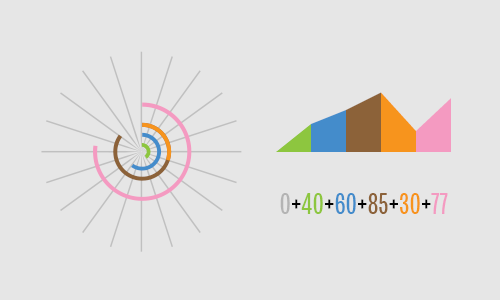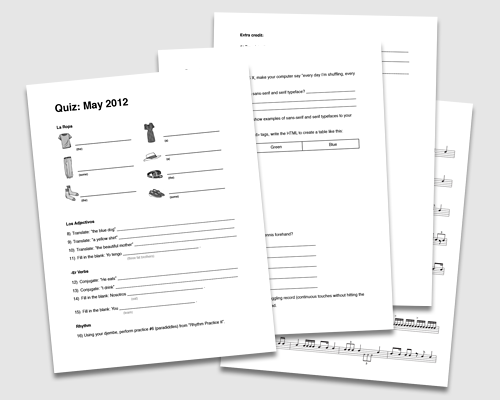Cameron Moll's Blog, page 10
May 14, 2012
Regret.
Kathryn Schulz, as quoted by Maria Popova:
If we have goals and dreams and we want to do our best, and if we love people and we don’t want to hurt them or lose them, we should feel pain when things go wrong. The point isn’t to live without any regrets, the point is to not hate ourselves for having them… We need to learn to love the flawed, imperfect things that we create, and to forgive ourselves for creating them. Regret doesn’t remind us that we did badly — it reminds us that we know we can do better.”
May 10, 2012
FF Chartwell, a Chart Font
Earlier today Erik Spiekermann made mention of FF Chartwell, and, at least conceptually, it’s pretty fantastic.
Similar to the way icon fonts replace keyboard characters with icons, FF Chartwell uses alphanumeric characters to generate beautiful charts on the fly. To my knowledge, however, this works only in software programs and can’t be embedded in web pages.
Update: It can be embedded. Demo by Yaron Schoen who says, “Besides the FOUT which was really hard (impossible?) to remove, it was glorious.”
The family includes “weights” for creating bar, line, radar, pie, rose, and ring charts. A simple math equation, such as 10+20+30, is all that’s needed to generate the chart. Each value can be assigned a color, which in turn becomes the value’s color in the chart.
In something such as Photoshop, it’s quite cumbersome to change the values, as you have to enable and disable the OpenType feature to do so. In other programs such as InDesign, this isn’t as cumbersome (as shown in the video above).
Here’s a simple example using Chartwell Rings and Chartwell Lines. The same equation is utilized in both charts:

Conceptually, I love the idea and hope to see this and other fonts expand to include webfont embedding, assuming the data could be represented semantically and accessibly. You can purchase FF Chartwell as a whole or as separate charts, and you can find additional usage examples on the FontFont blog.
May 8, 2012
Homeschool Quizzing for Four Grade Levels
TL;DR: It’s challenging.
Some of you know we homeschool our four children. Their U.S. grade levels range from 1st to 6th grade. Suzanne teaches them Monday through Thursday, and I put in a half-day on Friday to school them in the morning.
Because Suzanne covers several of the foundational topics such as math, science, and history, I complement their studies with less fundamental things like Spanish, sports, music, and computers (most notably HTML & CSS). One might argue these latter subjects are equally foundational, but that’s another topic for another day.
It’s quite challenging, as you might expect, to gather, produce, and teach curriculum to four different grade levels simultaneously. I won’t delve into how we do it, as that’s also another topic for another day.
Instead, I’ll simply share our latest quiz (PDF) from last Friday, encompassing the four subjects I’m currently teaching:
Created somewhat hastily in Pages (questions) and Illustrator (rhythm exercises), they certainly aren’t anything to brag about in terms of production quality. And this is only one of four quizzes. Each child gets a different version of the quiz according to their grade level and educational maturity.
What’s notable, I think, is that this latest quiz was our most comprehensive yet. It covers quite a bit of material, in part because the last quiz I issued was back in January 2012. A crazy work schedule in recent weeks hasn’t allowed me to stay on top of schooling as much as I’d like. Which, you guessed it, is another topic for another day — that of adequately educating our children while balancing the rest of life’s demands.
All of this rambling and quiz tomfoolery leads to this pro tip and the real reason for this post: I’ve found it helpful to create the quiz for the most senior grade level first, and then pair down a) the volume of questions and b) the difficulty of the questions. This makes the insurmountable task of creating quizzes for four grade levels a little less impossible.
Note that I’ve said nothing about quizzing itself and the debate among homeschoolers about testing your children. Regardless of those debates, I find quizzes to be helpful to evaluate how I’m doing as a teacher and to gauge how they’re internalizing what I teach.
Hopefully, something I’ve said here is helpful for those of you currently homeschooling or those of you considering it. If you haven’t already, you’ll discover homeschooling is precisely the same as parenting: Read as many books and blogs as you’d like, but at the end of the day, it’s all about trial and error. Lest you think I have this quizzing thing figured out (and homeschooling in general), I’ve made plenty of errors and continue to error.
Maybe I’ll share that story another day, too.
April 25, 2012
Don’t Expect Applause
Seth Godin:
If your work is filled with the hope and longing for applause, it’s no longer your work—the dependence on approval has corrupted it, turned it into a process where you are striving for ever more approval.
Who decides if your work is good? When you are at your best, you do. If the work doesn’t deliver on its purpose, if the pot you made leaks or the hammer your forged breaks, then you should learn to make a better one. But we don’t blame the nail for breaking the hammer or the water for leaking from the pot. They are part of the system, just as the market embracing your product is part of marketing.
April 23, 2012
Newcastle
An impromptu compilation using footage I gathered during my stay in Newcastle Upon Tyne and Gateshead (UK).
This was my first visit to Newcastle, in town to speak at DIBI 2012. I flew in Sunday evening, dropped off my luggage, grabbed my camera, and proceeded to lose myself in the streets of the city. The camera captured what I saw. I later debuted this video during my presentation.
I didn’t have a tripod with me as I was traveling light. I won’t make a blunder like that again. (Some shots stabilized in post.)
April 4, 2012
Skipping vs. Internalizing
Stephen Anderson, commenting on concerns within the community regarding "skipping the critical IA step" or "ditching wireframes to go straight to hi-fidelity":
Human beings don't think about content separate from presentation separate from structure separate from (fill in the blank)… We experience the world around us as one integrated whole. By insisting that we create these artificial distinctions [with clients and our projects], we confuse more than help.
Asking someone to comment just on the interaction or just on the structure — independent of the other pieces — is a bit like asking someone to judge a chocolate chip cookie based on only a handful of ingredients. 'Here, these are the wet ingredients (eggs, sugars, vanilla) — what do you think of this cookie?'
How can we possibly expect to get good feedback on such an incomplete experience?
/via @jmspool
“Creativity is a Verb”
Milton Glaser, as quoted in Jonah Lehrer’s Imagine:
There’s no such thing as a creative type. As if creative people can just show up and make stuff up. As if it were that easy.
I think people need to be reminded that creativity is a verb, and very time-consuming verb. It’s about taking an idea in your head, and transforming that idea into something real. And that’s always going to be a long and difficult process. If you’re doing it right, it’s going to feel like work.”
"Creativity is a Verb"
Milton Glaser, as quoted in Jonah Lehrer's Imagine:
There's no such thing as a creative type. As if creative people can just show up and make stuff up. As if it were that easy.
I think people need to be reminded that creativity is a verb, and very time-consuming verb. It's about taking an idea in your head, and transforming that idea into something real. And that's always going to be a long and difficult process. If you're doing it right, it's going to feel like work."
March 29, 2012
‘Paper’ for iPad
There are so many things right about this app. The lovely watercolor, miniature sketchbook icon. The marketing site. The “take this everywhere life takes you” video above. And the undo gesture: Place two fingers on the screen and draw a circle counter-clockwise to undo and clockwise to redo. (Though the number of undo/redo steps are limited.)
Download the app for free, and then purchase additional brushes for $1.99 or the entire set for $7.99. But I bet you’ll be really impressed with the calligraphy brush, which comes with the free app. Handwriting and sketching have never looked so good on iPad.
/via @gt
'Paper' for iPad
There are so many things right about this app. The lovely watercolor, miniature sketchbook icon. The marketing site. The "take this everywhere life takes you" video above. And the undo gesture: Place two fingers on the screen and draw a circle counter-clockwise to undo and clockwise to redo. (Though the number of undo/redo steps are limited.)
Download the app for free, and then purchase additional brushes for $1.99 or the entire set for $7.99. But I bet you'll be really impressed with the calligraphy brush, which comes with the free app. Handwriting and sketching have never looked so good on iPad.
/via @gt
Cameron Moll's Blog
- Cameron Moll's profile
- 4 followers




